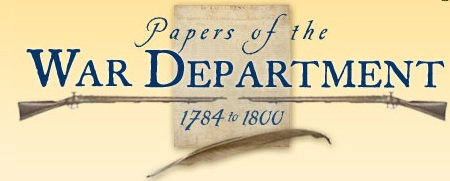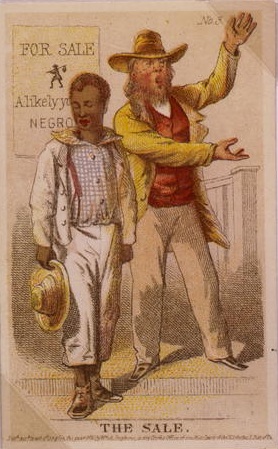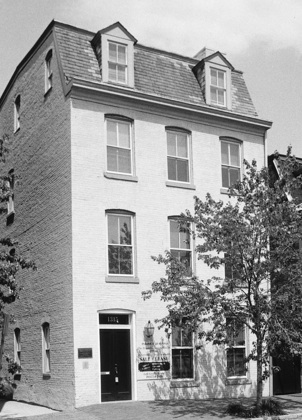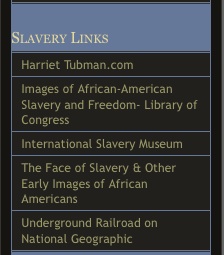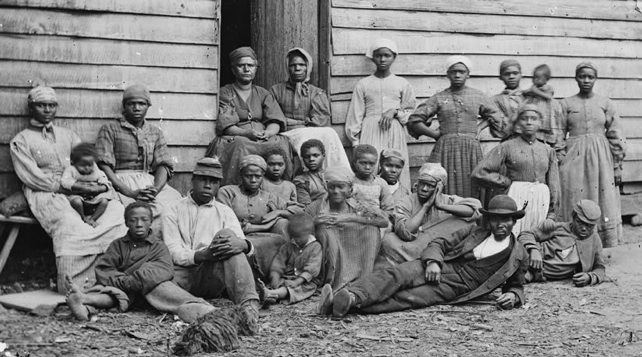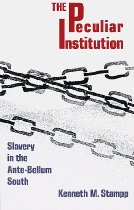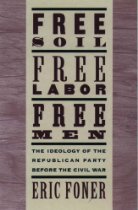On the night of November 8, 1800, fire devastated the United States War Office, consuming the papers, records, and books stored there. Two weeks later, Secretary of War Samuel Dexter lamented in a letter that “All the papers in my office [have] been destroyed.” For the past two centuries, the official records of the War Department effectively began with Dexter’s letter. Papers of the War Department 1784-1800, an innovative digital editorial project, will change that by making some 55,000 long lost documents of the early War Department available online to scholars, students, and the general public. By providing free and open access to these previously unavailable documents, Papers of the War Department 1784-1800 will offer a unique window into a time when there was no law beyond the Constitution, when the federal government hardly existed outside of the Army and Navy, and when a new nation struggled to define itself at home and abroad.
Archive for November 2008
Book Review: Two Brothers, One North, One South
Jones, David H. Two Brothers, One North, One South. Encino, CA: Staghorn Press, 2008. 320pp, ISBN 13: 978-0-9796898-5-7, $24.95.
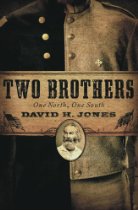 In his historical novel, David H. Jones tells the story of the the Prentiss brothers, William and Clifton, who fight on opposite sides of the American Civil War. The primary narrator is era poet, Walt Whitman, who befriends a dying William in the military hospital at the close of the war. In the young Confederate’s final days, he recounts to Mr. Whitman his experiences which Whitman, in turn, finds opportunity to share with brother Clifton, a Union officer, who lies wounded in the same hospital. They are joined by family members who collect around Clifton following William’s death.
In his historical novel, David H. Jones tells the story of the the Prentiss brothers, William and Clifton, who fight on opposite sides of the American Civil War. The primary narrator is era poet, Walt Whitman, who befriends a dying William in the military hospital at the close of the war. In the young Confederate’s final days, he recounts to Mr. Whitman his experiences which Whitman, in turn, finds opportunity to share with brother Clifton, a Union officer, who lies wounded in the same hospital. They are joined by family members who collect around Clifton following William’s death.
The story tells of young Southern men dashing off to join the fight and courageous Southern women who persuade politicos to contribute arms and supplies to Southern recruits and who even become blockade runners to ensure that those supplies reach the troops. We are witness to a number of key battles of the war, introduced to the weapons used, and generally educated about what it would have been like to serve in, primarily, the Confederate ranks. There is significantly less information provided through the storyline about the war experiences of brother Clifton and the Northern perspective.
What is unique about the novel is that the brothers featured were real and many will find the facts surrounding their lives, so carefully researched, intriguing. The presentation of the novel is also stylistically unique in that it is written using the formal language of the era.
I had the sense in reading Two Brothers that Jones struggled to nail down the book’s genre as he set about writing it. The work often resembles non-fiction with much “telling” of history rather than the “showing” of character-driven action and drama that makes for good fiction. While the “telling” made for interesting history, as a piece of fiction, the book was less than satisfying. That said, Civil War buffs will enjoy the military aspects of the book which are well researched.
Acquisition: An Army At Dawn: The War in North Africa, 1942 – 1943 Plus…
Just a note that I’ve picked up a copy of An Army at Dawn: The War in North Africa, 1942-1943 by Rick Atkinson. This book, the first in his Liberation Trilogy, won the Pulitzer Prize. I was quite impressed by Mr. Atkinson’s book, Crusade: The Untold Story of the Persian Gulf War, which I reviewed here.
Paperback: 768 pages
Publisher: Holt Paperbacks; Revised edition (May 15, 2007)
Language: English
ISBN-10: 0805087249
ISBN-13: 978-0805087246
I also purchased the second book in the trilogy, The Day of Battle: The War in Sicily and Italy, 1943-1944, which many reviewers have indicated surpasses the first.
Paperback: 848 pages
Publisher: Holt Paperbacks; Reprint edition (September 16, 2008)
Language: English
ISBN-10: 080508861X
ISBN-13: 978-0805088618
Even better, I’ve discovered that most of Mr. Atkinson’s books are available in audio format free from my local public library and so they will be on my MP3. Sweet!
Fantastic Site – George Mason’s Center for History and New Media
Today I discovered a remarkable site, George Mason University’s Center for History and New Media which you can access here. It’s really about exploring history using digital media. It has three broad sections.
- Teaching + Learning
- Research + Tools
- Collecting + Exhibiting
Not only do I like the site’s premise but it makes available some outstanding tools including Zotero which I downloaded and began using today. It is an extension to Firefox designed “to help you collect, manage, and cite your research sources.” It was very easy to install and is free.
Another find linked to the site is the “Papers of the War Department 1784-1800.”
The CHNM site is well worth a visit and some serious exploration for historians and students alike. I’ll be adding to my links. Highly Recommend.
American Rifle, A Biography
Under the guise of a Christmas gift for my husband, I have acquired a copy of Alexander Rose’s new book, American Rifle, A Biography. I have reluctantly agreed with him that he should thus have the opportunity to read it first.
Alex has been getting some outstanding reviews including one from the Washington Post which you can read here. You can catch up on more reviews over at Alex’s blog here.
Hardcover: 512 pages
Publisher: Delacorte Press (October 21, 2008)
Language: English
ISBN-10: 0553805177
ISBN-13: 978-0553805178
Product Dimensions: 9.1 x 6.1 x 1.5 inches
Lincoln and His Admirals
I’m very pleased to have received a review copy yesterday of Lincoln and His Admirals by Craig L. Symonds from the terrific folks over at Oxford University Press. You can view the book’s listing at OUP here. Being a student of both the American Civil War AND maritime history, I can’t think of a better read. I’m reserving this one for the Christmas holiday. This will also be my first introduction to the work of Craig L. Symonds. More to come on my review.
Hardcover: 448 pages
Publisher: Oxford University Press, USA (October 17, 2008)
ISBN-10: 0195310225
ISBN-13: 978-0195310221
Dimensions: 9.2 x 6.3 x 1.5 inches
On Slavery – 8: The “Peculiar Institution”
I believe the use of the phrase “peculiar institution” was intended to convey the highly contradictory nature of the practice of human ownership in a country based on equality and freedom. Regardless of what perspective one might have of slavery in America, it is difficult to argue against the fact that these contradictions existed. Historian Kenneth Stampp’s chapter titled “Between Two Cultures,” in his book, The Peculiar Institution: Slavery in the Ante-Bellum South, provides several compelling examples.
1. American culture was heavily influenced by religion and yet the South used that religion to justify slavery.
2. Morality of the day frowned on fornication and yet the laws of the day prohibited slaves from legally marrying, thus not only condoning but also encouraging slaves to live out-of-wedlock. Slave owners preached “virtue and decency…” but then wondered why there was widespread sexual promiscuity. Add to this the “hypocrisy in white criticism of their moral laxity” when masters used their slaves “to satisfy an immediate sexual urge.”
3. Rape of a white woman by a slave was punishable by death but “no such offense against a slave woman was recognized in law.”
4. The family was critically important to white culture but the “peculiar institution” condoned the intentional undermining of normal family structures among bondsmen because it best suited their owner’s economic goals as well as furthering command and control of laborers. “The family had no great importance as an economic unit.” And the Protestant South was highly tolerant of slave owners who separated spouses and families.
5. Stampp points out that “the enterprising, individualistic, freedom-loving, self-made man” attained the greatest respectability in white society of the 19th century. And yet slaves were given no opportunity to even hope to aspire to this level of respectability.
6. Rather than a society based on equality, the South developed a highly stratified caste system.
And so I contend that embracing slavery left the South at odds with itself, the North, and much of the rest of the world. And yet embrace it, it did. Use of the phrase “peculiar institution” instead of “slavery” was yet another way in which the South struggled to reconcile the irreconcilable.
Kenneth M. Stampp, The Peculiar Institution: Slavery in the Ante-Bellum South.
On Slavery – 7 Slavemongering
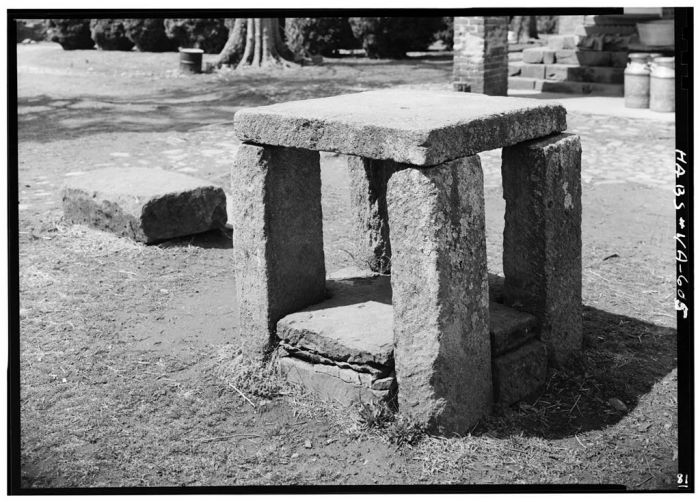
Green Hill Plantation, Slave Auction Block, State Route 728, Long Island vicinity, Campbell County, VA Courtesy of the Library of Congress
Many words lose their relevance and thus usage over time. Fortunately, slavemongering, is among them.
A monger is defined as a dealer or trader. To monger is to promote or deal in something specified. It is generally used in a composition. Thus a costermonger is an itinerant fruit-seller, a fellmonger is a dealer in skins, a fishmonger peddles fish, and an ironmonger is a dealer in iron goods.
Walter William Skeat’s An Etymological Dictionary of the English Language, suggests as possible source of the word.
monger, mangere a dealer merchant formed with suffix ere from mang ian – to traffic barter gain by trading.
The relationship to the Lat[in] mango, a dealer in slaves, is not clear but the [English] word does not appear to have been borrowed from it. [1]
Slaves were “inseparable from any species of private property” and since “titles to slaves were transferable,” their owners had the power of conveyance. [2] Thus the legality of slavemongering, or the trafficking of slaves, was firmly established in the Antebellum South.
Slave owners seemed somewhat ambivalent to the idea of slavemongering. Some despised the idea but took advantage of it non-the-less. Thus one who found the sale of a bondsman distasteful or even bordering on amoral, could unburden themselves of their human property using a professional.
Franklin & Armfield had the distinction of being the the largest slave-trading enterprise in the South at least during the period prior to the Panic of 1837. Formed in 1828, its principles were John Armfield and Isaac Franklin. They each “accumulated fortunes in excess of a half million dollars” before retiring. [2]
Hundreds of small entrepreneurs engaged in slave trade but only a few made large sums of money. Among these few was Nathan Bedford Forrest who “was the largest slave trader in Memphis during the late 1850’s; he was reputed to have made a profit of $96,000 in a single year.” [2]
[1] Walter William Skeat, An Etymological Dictionary of the English Language, accessed on the internet via Google Books, November 22, 2008 here.
[2] Kenneth M. Stampp, The Peculiar Institution: Slavery in the Ante-Bellum South.
History Blog “Cliopatria Award” Nominations Due by 11/30!
OK history buffs… George Mason University’s History News Network does its bit to encourage history bloggers with its annual Cliopatria Awards, but it needs nominations from readers like you. Intended to “recognize the best history writing in the blogosphere,” nominated history blogs will be considered for six award categories:
“Bloggers, blogs and posts may be nominated in multiple categories. Individuals may nominate any number of specific blogs, bloggers or posts, even in a single category, as long as the nominations include all the necessary information (names, titles, URLs, etc).
Nominations will be open through November; judges will make the final determinations in December. The winners will be announced at the American Historical Association Annual Meeting in early January 2009; winners will be listed on HNN and earn the right to display the Cliopatria Awards Logo on their blog.”
Now get out there and nominate aggressively! Click here for nomination information.
2008 National Book Award Winner: The Hemingses of Monticello: An American Family
Congratulations to Annette Gordon-Reed for winning the 2008 National Book Award for non-fiction.
Annette Gordon-Reed 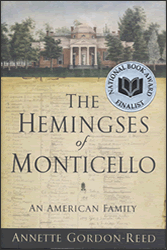
The Hemingses of Monticello: An American Family
W.W. Norton & Company
CITATION
“In the mesmerizing narrative of Annette Gordon-Reed’s American family saga, one feels the steady accretion of convincing argument: Her book is at once a painstaking history of slavery, an unflinching gaze at the ways it has defined us, and a humane exploration of lives—grand and humble—that “our peculiar institution” conjoined. This is more than the story of Thomas Jefferson and his house slave Sally Hemings; it is a deeply moral and keenly intelligent probe of the harsh yet all-too-human world they inhabited and the bloodline they share.”
Link Updates
Over the weekend, I added quite a few links to the right navbar which I use to keep myself organized. Here’s a quick run down of several of the new adds. There’s a theme in here somewhere….
- Links to all state historical societies
- The Historical Maritime Society
- Smith’s Master Index to Maritime Museums (WOW!)
- Portsmouth Historic Dockyards (GO if you get a chance!)
- Five excellent new links to sites related to slavery filed under “Slavery Links”
Abraham Lincoln: A Presidential Life
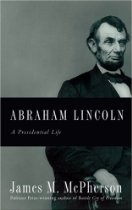 Yesterday, I was pleased to receive a review copy of James M. McPherson’s upcoming release, Abraham Lincoln: A Presidential Life from Oxford University Press. It is scheduled to be released on the date marking the 200th year since Lincoln’s birth. While I’ve yet to complete it, I was impressed by Dr. McPherson’s candor in the introduction about his own shift in opinion about Lincoln and his presidency. While initially critical of Lincoln, not unlike the abolitionists of the era of his presidency, McPherson’s years of study brought new appreciation for Lincoln’s skills as an adroit commander-in-chief tasked with challenges of incredible complexity.
Yesterday, I was pleased to receive a review copy of James M. McPherson’s upcoming release, Abraham Lincoln: A Presidential Life from Oxford University Press. It is scheduled to be released on the date marking the 200th year since Lincoln’s birth. While I’ve yet to complete it, I was impressed by Dr. McPherson’s candor in the introduction about his own shift in opinion about Lincoln and his presidency. While initially critical of Lincoln, not unlike the abolitionists of the era of his presidency, McPherson’s years of study brought new appreciation for Lincoln’s skills as an adroit commander-in-chief tasked with challenges of incredible complexity.
Hardcover: 96 pages
Publisher: Oxford University Press, USA (February 1, 2009)
Language: English
ISBN-10: 0195374525
ISBN-13: 978-0195374520
Product Dimensions: 8 x 5.1 x 0.7 inches
On Slavery – 6 Chattels Personal
Kenneth Stampp’s chapter “Chattels Personal” is excellent. I suspect that “chattel” is not a word most of us learn unless we study law or Antebellum American history in depth. Its meaning in the context of slavery is, of course, that person’s slaves were consider legally as “chattel personal.”
Being a person quite taken with words, I did a little research on the origins of this one and found it informative. Interestingly, a search for the etymology of the word found some disagreement. The following perspective comes from French: A Linguistic Introduction.
“Chattel comes from the French noun cheptel used to designate all movable property, but now is restricted to ‘livestock’. English has gone a step further: cattle used to designate any movable property, then all livestock, and now is generally restricted to bovines. English also has the word chattel, legally any type of movable property, but more specifically in modern usage, it refers to slaves. All of these terms are ultimately derived from the Latin word capitalis, which has been reintroduced in modern financial vocabulary, e.g. capital campaign in fundraising. This term, in turn, is derived from the Latin word caput, ‘head’ (French chef), with the result that ‘head of cattle’, our original example, ultimately is a ‘head of things with heads’!” [1]
This from A New Law Dictionary and Glossary…
“…the singular chattel seems to be immediately formed from the Fr. chatelle, or chatel, (q.v.); the plural chattels, (or, as it was formerly written, catals,) is supposed to be derived from the L. Lat., catalla, the ch being pronounced hard, as in the word charta, which is evident from the form of the old Norman plural, cateux, (q.v.). As to any further derivation, catalla or catalia is clearly shown by Spelman to be merely a contracted form of writing capitalia, which with the singular capitale, or captale, occurs frequently in the Saxon and early English laws. The primary meaning of capitalia was animals, beasts of husbandry, (otherwise call averia, q.v.) or cattle; in which last word it is still identically retained.
Capitalia is derived by Spelman from capita, heads; a term still popularly applied to beasts, as “so many “heads of cattle.” When the word took the form catalla, it continued to retain this primary meaning, but gradually acquired the secondary sense of movables of any kind, inanimate as well as animate, and finally became used to signify interests in lands.”
CHATTELS PERSONAL, otherwise called THINGS PERSONAL, comprise all sorts of things movable, as good, plate, money, jewels, implements of war, garments, animals and vegetable productions; as the frit or other part of a plant, when severed from the body of it, or the whole plant itself, when severed from th ground. Besides things moveable, they include also certain incorporeal rights or interestes, growing out of, or incident to them, such as patent rights and copyrights…” [2]
——
[1] French: A Linguistic Introduction
By Zsuzsanna Fagyal, Douglas Kibbee, Fred Jenkins
Published by Cambridge University Press, 2006
ISBN 0521821444, 9780521821445
337 pages (pp. 154-155), Accessed online, November 16, 2008, http://books.google.com/books?id=4yTA6SvGuekC&pg=PP1&dq=French:+A+Linguistic+Introduction#PPA154,M1
[2] A New Law Dictionary and Glossary
By Alexander M. Burrill
Published by The Lawbook Exchange, Ltd., 1998
ISBN 1886363323, 9781886363328
1099 pages (pp. 207-208), Accessed online, November 16, 2008, http://books.google.com/books?id=DeQYXYMBtwgC&printsec=frontcover&dq=etemology+of+the+word+chattel#PPA208,M1
Kenneth M. Stampp, The Peculiar Institution: Slavery in the Ante-Bellum South.
On Slavery – 5 Escaping
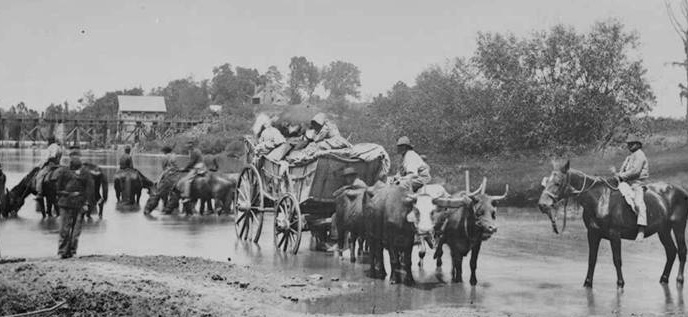
Historian Kenneth Stampp makes an interesting point about differing locations of slaves determining the destination of escapees. Those living near Indians might, for example, seek refuge with local tribes, as was the case in Florida.
“…Florida slaves escaped to the Seminole Indians, aided them in their wars against the whites, and accompanied them when they moved to the West. At Key West, in 1858, a dozen slaves stole a small boat and successfully navigated it to freedom in the Bahamas. Arkansas runaways often tried to make their way to the Indian country.” (Stampp, 120)
Those nearer to the north often choose to escape to the north where there was a greater presence of abolitionists.
Those in Texas would escape in larger numbers to Mexico.
“In Mexico the fugitives generally were welcomed and protected and in some cases sympathetic peons guided them in their flight.” (Stampp, 120)
Kenneth M. Stampp, The Peculiar Institution: Slavery in the Ante-Bellum South
On Slavery – 4

Cotton Harvest, U.S. South,1850s Reference BLAKE4, as shown on http://www.slaveryimages.org, sponsored by the Virginia Foundation for the Humanities and the University of Virginia Library.
The experience of slaves could vary by region due in large part to the type of product the slave was engaged in bringing to market. Slaves in the hemp producing regions of Kentucky and Missouri, worked in rhythm with the cycles required by the crop. Similarly, slaves who worked in cotton producing areas (above) or regions in which tobacco was cultivated, would have had daily and seasonal work routines aligned with those crops. Regional weather would also have differentiated the experience of slaves in different parts of the south.
Slaves rented out to work in industrial areas with factories would have had a decidedly different experience than those working on a plantation. Author Kenneth Stampp suggests that factory slaves enjoyed more freedom and yet an equal if not higher incidence of overwork. The daily experience of slaves living in urban centers would have been decidedly different than rural slaves. Domestic assignments were not uncommon.
On Slavery – 3
[This post continues the series On Slavery (1 here and 2 here).]

"Flogging the Negro" (Cropped) Full Image Reference NW0213, as shown on http://www.slaveryimages.org, sponsored by the Virginia Foundation for the Humanities and the University of Virginia Library.
Kenneth Stampp in his book, The Peculiar Institution: Slavery in the Ante-Bellum South, suggests that some owners of slaves were conflicted about the need to apply punishment in the control of slaves and yet most felt fully justified in imposing that control. He sites on numerous occasions the willingness of owners to overlook the cruelty of overseers if they met or exceeded production goals. This head-in-the-sand approach to ethics undoubtedly had many causes but the most obvious was greed.
Owners also considered their slaves to have a “duty” to their master by virtue of the fact that they were, after all, his property and that the master provided and cared for them. But the most prevalent justification for imposing control on the slaves was to achieve maximum production from them as a labor force. Poor performers, for whatever reason, were seen as impacting the bottom-line.
On Slavery – 2
Continuing from On Slavery – 1 here.
 Marie Jenkins Schwartz in her OAH Magazine of History article, “Family Life in the Slave Quarters: Survival Strategies,” points out that slave masters attempted to control slave children by disrupting the normal authority they might feel towards their parents.
Marie Jenkins Schwartz in her OAH Magazine of History article, “Family Life in the Slave Quarters: Survival Strategies,” points out that slave masters attempted to control slave children by disrupting the normal authority they might feel towards their parents.
“Masters and mistresses considered the slave’s most important relationship to be that maintained with an owner. They worried that children reared to respect other authority figures, such as parents, might question the legitimacy of the southern social order, which granted slaveholders sweeping power over the people they held in bondage. Consequently, owners planned activities and established rules intended to minimize the importance of a slave’s family life and to emphasize the owner’s place as the head of the plantation.”
Schwartz further suggests that a number of slave owners referred to their slaves a family members and though not treated as such, this helped in their self–justification of exercising full power and control over every aspect of a slave’s life.
On Slavery – 1

Photograph of Slave Cabin and Occupants Near Eufala, Barbour County, Alabama (Photo source: Library of Congress)
I’m reading Kenneth M. Stampp’s fascinating book, The Peculiar Institution: Slavery in the Ante-Bellum South for class. A focus this week and next is, among other things, the ways in which slave owners controlled their bondsmen. The methods varied considerably as did the ethical sensibilities of the masters and overseers. Stampp suggests that behavioral control included both the carrot and the stick with heavy weighting on the stick. That is to say, some masters and/or overseers used positive incentives and some negative.
Positive incentives included: work stoppage at noon on Saturdays and Sunday off, holidays off, parties and dances, holiday gifts, cash for the best worker for a given period, the right to grow one’s own crops whether for personal food or sale, the right to rent oneself out and keep some of the income, and the ultimate incentive, the right to achieve freedom.
Negative incentives were many. Stampp suggests that few adult slaves did not have some experience with flogging. This seemed to be the most acceptable method of disciplining slaves and was used extensively. Other forms of physical punishment used to control slaves included: confinement either in “the blocks” or even jail, mutilation (ranging from castration to branding), and even more severe forms of torture. For young slaves or those who needed “breaking,” there were actually specialists who through, undoubtedly mental and physical persuasion, reduced high spirited individuals to more pliable and subservient workers.
Another method of control was the introduction of religion to the slaves. Indoctrination of slaves into Christianity had its advantages. It was not uncommon for them to ensure that sermons emphasized those verses in the Bible that instructed servants to obey their masters. (Stampp, 158) Particular focus was made on teaching slave children “respect and obedience to their superiors” in the belief that it made them better servants. (Stampp, 159) This suggests a fascinating area of study – the effects of religion on American slaves – for which I must look for information. Let me know if you can recommend any.
Antebellum America Course Underway, New Books
Class has started, Antebellum America. Books have been added to the reading list, some familiar and respected authors.
First up, The Peculiar Institution: Slavery in the Ante-Bellum South by Kenneth M. Stampp.
And, Free Soil, Free Labor, Free Men by Eric Foner.
And so we watch history being made…
It’s poignant that I’ve started a course this week that examines antebellum America – a country of profound inequality and bigotry. If you are an American, regardless of who you voted for, I hope you celebrate the process of democracy that we shared in together today. And marvel at the incredible journey that this country has made to this important day.
What a transformational moment in history…
What a time to be a student of history…
Civil War Battlefield Assessment – Vicksburg National Military Park Scores only “Fair”
On October 29, 2008, the National Parks Conservation Association’s Center (NPCA) for the State of the Parks released the first of ten Civil War park assessments. It presented a “good news – bad news” story. According to Perry Wheeler, with the NPCA, the Vicksburg assessment…
“…finds that overall conditions of the park’s known cultural resources rated a score of 67 out of 100, indicating fair conditions. This score includes ratings for the park’s historic structures, cultural landscapes, archaeology sites, and extensive museum collection.” [The Vicksburg assessment is available in its entirety by clicking here.]

National Park Service Photo: Vicksburg National Military Park commemorates the siege of Vicksburg and the ensuing battle, widely considered one of the most important campaigns of the Civil War.
Wheeler indicated that a recent grant of $142,000, “received as part of the National Park Centennial Challenge program, additional maintenance funding and staff needs” will help, but it’s only a start.
“NPCA’s assessment found that the park is in need of an additional 9.4 full-time employees and roughly $716,000 in funding, which obviously the grant will help with. The park currently has only two full-time cultural resource staff: a historian and a museum curator.
Furthermore, Vicksburg’s interpretive staff consists of only two interpreters, two guides, and one supervisory park ranger — not enough to serve the 700,000 people who visit the park each year. Current staff levels equal 140,000 visitors per ranger each year!!”
If you’re not a supporter, consider becoming one or help spread the word.
Find out how on the Civil War Preservation Trust site here.
The Vicksburg National Military Park photostream on flickr is available here.
2008 National Book Award Finalists in Non-Fiction
First, I’ve added The National Book Foundation to my links (look under “Books” header on right nav bar.
Second, I noticed several history and military-relevant titles on the 2008 National Book Award Finalist list for non-fiction. My congratulations to all of the finalists.
Drew Gilpin Faust
This Republic of Suffering: Death and the American Civil War
Alfred A. Knopf
Annette Gordon-Reed
The Hemingses of Monticello: An American Family
W.W. Norton & Company
Jane Mayer
The Dark Side: The Inside Story of How the War on Terror Turned into a
War on American Ideals
Doubleday
Jim Sheeler
Final Salute: A Story of Unfinished Lives
The Penguin Press
For the Common Defense
Peter Maslowski and Allan R. Millett. For the Common Defense: A Military History of the United States of America. Enlarged edition. Simon & Schuster, 1994. See the book on publisher’s site here.
This monumental survey of American military history has three stated purposes. The first is to analyze the development of military policy. The second is to examine the characteristics and behavior of the United States armed forces in the execution of that policy and the third is to illuminate the impact of military policy on America’s international relations and domestic development. Millett and Maslowski propose that there are six major themes that position military history within the larger context of American history. These include the following and are quoted from the text.
- Rational military considerations alone have rarely shaped military policies and programs. The political system and societal values have imposed constraints on defense matters.
- American defense policy has traditionally been built upon pluralistic military institutions, most
 notably a mixed force of professionals and citizen-soldiers.
notably a mixed force of professionals and citizen-soldiers. - Despite the popular belief that the United States has generally been unprepared for war, policy makers have done remarkably well in preserving the nation’s security.
- The nation’s firm commitment to civilian control of the armed forces requires careful attention to civil-military relations.
- The armed forces of the nation have become progressively more nationalized and professionalized.
- Beginning in the mid-nineteenth century, but especially during the twentieth century, industrialization has shaped the way the nation has fought.
The authors further suggest that Americans do not consider themselves a warring people but have in fact become involved in a number of conflicts and that because of this, the study of the United States’ military history is important in if one hopes to gain better insight into both America’s history and its current and future identity.
Millett and Maslowski structure their book chronologically, which is completely fitting. They begin with a survey of colonists from 1609 – 1689. They devote a chapter as well to the Colonial Wars that occurred between 1689 and 1763. The American Revolution follows and includes the years between 1763 and 1783. Two chapters cover the military history of the new republic including its expansion. This includes the period 1783 – 1860 after which the country is on the precipice of civil war. Two chapters are devoted to the American Civil War the first focusing on the early years of 1861 and 1862. The second surveys the years between 1863 and the war’s end in 1865. And so the format continues covering major years of either military growth or conflict through to two great wars. Several chapters are devoted to the period spanning the Cold War during which the Korean War took place. The Vietnam War covers the period from 1961 – 1975. The periods marking the end of the Cold War follow and then a chapter is devoted to the Gulf War.The book was written and published in its revised format prior to the Iraq War.
Millett and Maslowski’s work provides outstanding bibliographies expanded in the revised edition to include selected references at the end of every chapter as well as a generous General Bibliography. It also includes an excellent set of illustrations and photographs. This work is intended for students of American military history and American history in general. It should also appeal to the reader who wants a perspective on the events of world history in which the American military has been engaged.
Both authors bring impeccable credentials to their authorship of this text. Allan R. Millett (see his 2007 vitae here) is the Raymond E. Mason Jr. Professor Emeritus of History from The Ohio State University. He is the Stephen Ambrose Professor of History at the University of New Orleans and Director of the Eisenhower Center  for American Studies at the National World War II Museum in New Orleans. He received his B.A. in English from DePauw University and his M.A. and Ph.D. in History from The Ohio State University. He is a retired colonel of the Marine Corps Reserve, and a specialist in the history of American military policy and 20th century wars and military institutions. He is one of the founders of the military history program at The Ohio State University. Dr. Millett was recently honored with the 2008 Pritzker Military Library Literature Award for Lifetime Achievement in Military Writing (see the news release here).
for American Studies at the National World War II Museum in New Orleans. He received his B.A. in English from DePauw University and his M.A. and Ph.D. in History from The Ohio State University. He is a retired colonel of the Marine Corps Reserve, and a specialist in the history of American military policy and 20th century wars and military institutions. He is one of the founders of the military history program at The Ohio State University. Dr. Millett was recently honored with the 2008 Pritzker Military Library Literature Award for Lifetime Achievement in Military Writing (see the news release here).
Peter Maslowski is Professor of History at the University of Nebraska where he specializes in the history of the Civil War, military, and Vietnam War. He received his B.A. from Miami University and M.A. and Ph.D. from The Ohio State University. Professor Maslowski served as the John F. Morrison Professor of Military History at the U.S. Army Command and General Staff from 1986 to 1987. In 2002, Professor Maslowski, a highly regarded teacher/lecturer, received the Outstanding Teaching and Instructional Creativity Award (OTICA). He is on the Advisory Board of the Gilder Lehrman Institute of American History. For an excellent interview with Professor Maslowski on his career, see the 2005 interview in the Daily Nebraskan here
I have found no other resource on U.S. Military History that is so comprehensive in nature. Recommend.



